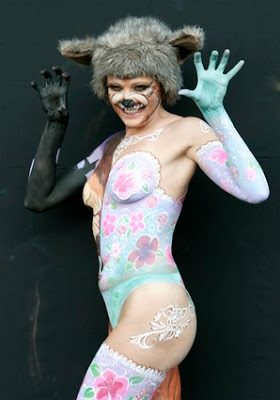 Body Art Painting With Many Colors Themed Abstract
Body Art Painting With Many Colors Themed AbstractAbstract Expressionism is a fascinating American contribution to the world of art. It was a movement that developed in New York during the decades immediately following World War II. Sometimes it is referred to as the New York School or as 'Action Painting'. It is characterized by an attempt to depict universal emotions. It is known as the first exclusively American movement to gain international recognition.
Artists who worked at abstract expressionism tended to concentrate on the physical process of painting, from which the narrower term 'Action Painting' was derived, often throwing paint at their canvases in an expressive and highly physical subversion of traditional methods of painting. Breton, Ernst and Masson, all leading Surrealists, moved to New York during World War II and were influential in its initial development. However, where the Surrealists explored the unconscious for means of disrupting society's cherished conventions, the Abstract Expressionists turned to the unconscious for symbols of universal meaning which could restore both art and society after World War II.
The psychologist Carl Gustav Jung was an important influence on these artists. He argued that archetypal, symbol-generating emotions and behavior can be found in every psyche and culture. The abstract expressionists believed that their painting expressed these universal symbols.
Within abstract expressionism is an interesting variant called Color Field Painting. It looks like an exact opposite of Action painting. Instead of having its rhythmic vitality, luminous and brooding colors saturate the canvas with contemplative stillness. If Action Painting captures the physical energy of dance, Color Field Painting evokes the psychic energy of contemplation.
By the 1960's, artist Philip Guston was one of a growing number who criticized Abstract Expressionism for having become a sterile, and decorative orthodoxy which was stifling creativity.
It is fascinating the way Abstract Expressionism often works to cause the observer to feel liberated from the burdens of individuality, class, nationality and gender. Significantly, it also helps to restore a much needed sense of common humanity. For example, Rothko's Untitled is characterized by luminous colors. When looked at directly, it has an iconic quality typical of many abstract expressionist paintings. The suggestion of a dark horizon in the center of the painting evokes universal feelings about distance and proximity, travel and arrival, containment and freedom.
Perhaps one of the most well known and revolutionary paintings is Jackson Pollock's Alchemy, 1947. In this painting, Pollock poured commercial paint directly onto his canvas with the help of a stick. This act dispersed with the traditional brush and easel and involved his entire body in the act of painting. The work has a physicality and energy typical of much Abstract Expressionism, Action Painting in particular. Alchemy refers to the ancient search for a means of transforming base matter into gold which Jung saw as symbolic of psychological transformation.
Abstract Expressionism is an intense, introspective, global type of art that elevates and informs. Obviously, it is subjectively experienced, yet objectively available. We bring our own backgrounds, insecurities, and other life experiences to an experience with this wonderful type of art. Something always worth the effort.
















No comments:
Post a Comment